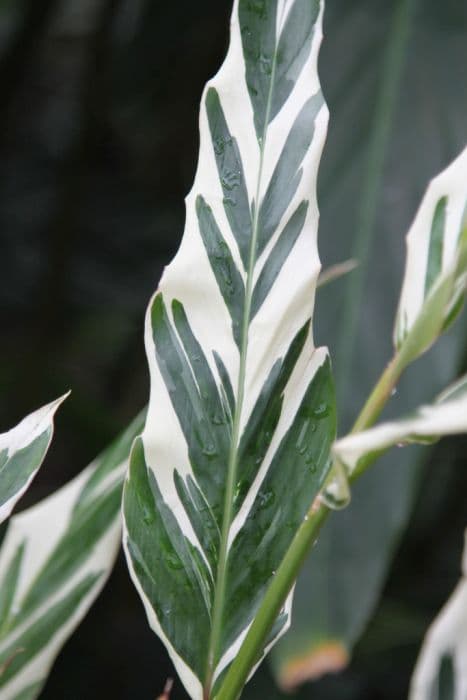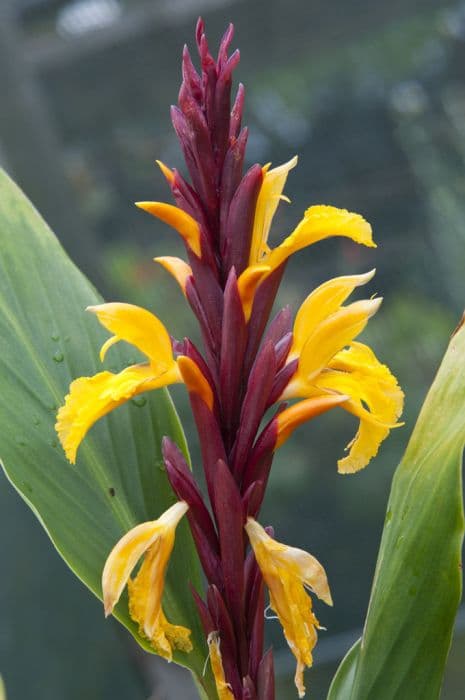Roscoea Roscoea scillifolia f. scillifolia

ABOUT
This plant displays a beautiful and unique appearance, primarily known for its attractive flowers and luscious foliage. The plant typically exhibits an upright growth habit with strong, straight stems that bear spear-shaped leaves. The leaves are generally a bright, glossy green, adding to the plant's vibrant look. The most captivating feature of this plant is its flowers. The blooms possess a distinctive shape that's reminiscent of some orchid species. They come in a range of colors, with various shades of purple being quite common, sometimes with intricate color patterns featuring different hues. These colorful flowers often have a hooded upper petal and a broader, lip-like lower petal, creating a striking contrast against the lush foliage. The plant tends to form clumps over time, with the foliage providing a rich backdrop for the stunning floral display. Each stem may hold a singular flower or sometimes a small cluster at the top, depending on the health and vigor of the plant. Its aesthetic makes it a desirable addition to garden spaces that are looking for a touch of exotic flair without requiring a large plant that takes up an ample amount of space. This plant's visual characteristics are such that they can add ornamental value to a garden throughout its growing season.
About this plant
 Names
NamesFamily
Zingiberaceae.
Synonyms
No common names available.
Common names
Roscoea scillifolia f. scillifolia.
 Toxicity
ToxicityTo humans
Roscoea scillifolia, commonly known as Roscoea, does not have a well-documented profile of toxicity to humans. As with any plant, individual sensitivities can vary, and it is generally advised to avoid ingesting plants that are not commonly recognized as food items due to the potential for allergic reactions or unknown toxicities. In the absence of specific information regarding its toxicity, it is prudent to refrain from consuming Roscoea scillifolia and to keep it out of the reach of children who might accidentally ingest it. If someone has ingested Roscoea scillifolia and is experiencing adverse symptoms, it is important to seek medical advice promptly.
To pets
When it comes to pets, Roscoea scillifolia, also known simply as Roscoea, does not appear to have a reputation for being toxic. However, the same caution advised for humans applies to pets: there is always a risk when a non-food plant is ingested, as individual animals may have sensitivities or allergies, and some plants contain compounds that can be harmful. Pet owners should prevent their animals from eating ornamental plants such as Roscoea and monitor them for any signs of illness if they do consume them. Symptoms of plant toxicity in pets can vary but often include vomiting, diarrhea, drooling, lethargy, or unusual behavior. If a pet shows signs of distress after ingesting this plant, it is important to consult a veterinarian as soon as possible.
 Characteristics
CharacteristicsLife cycle
Perennials
Foliage type
Deciduous
Color of leaves
Green
Flower color
Purple
Height
1 foot [30 cm]
Spread
1 foot [30 cm]
Plant type
Herb
Hardiness zones
6
Native area
China
Benefits
 General Benefits
General Benefits- Attracts Pollinators: Roscoea scillifolia f. scillifolia, commonly known as Scillifolia Roscoea, often attracts bees, butterflies, and other beneficial insects, supporting local ecosystems.
- Aesthetic Appeal: Featuring attractive purple flowers, it adds visual interest and beauty to gardens and landscapes.
- Low Maintenance: Scillifolia Roscoea generally requires minimal care once established, making it suitable for gardeners of all skill levels.
- Tolerance to Shade: It can thrive in partially shaded areas where other sun-loving plants might struggle.
- Drought Resistance: Once established, the plant has a degree of drought resistance, making it suitable for dry or xeric gardens.
- Cultural Significance: The Scillifolia Roscoea may hold cultural or traditional significance in certain regions, adding intangible value to gardens.
- Soil Stabilization: The root system can help stabilize soil, preventing erosion in certain garden setups.
- Culinary Use: Some parts of the plant might be used in cooking for those knowledgeable about edible flowers and plants.
 Medical Properties
Medical Properties- This plant is not used for medical purposes.
 Air-purifying Qualities
Air-purifying QualitiesThis plant is not specifically known for air purifying qualities.
 Other Uses
Other Uses- Roscoea scillifolia, commonly known as Roscoea, can be used in ornamental shade gardens for its attractive foliage and flowers.
- The plant can serve as a natural pest deterrent due to its unique scent, which may repel certain insects when planted in a mixed border.
- The corms of Roscoea may be used as a starch-rich food source in times of scarcity, though this is not a common practice.
- Due to their fibrous nature, the leaves of Roscoea may be utilized in the production of handmade paper or natural textiles.
- Roscoea flowers can be used as a natural dye, imparting a soft color to fabrics or artisanal crafts.
- The stems of Roscoea can be woven into small baskets or decorative items by skilled craftspeople.
- Cultivated Roscoea plants can play a role in supporting local biodiversity by providing habitat for pollinators such as bees and butterflies.
- When dried, the seeds of Roscoea can be used in the creation of rattles or as a filler for percussive musical instruments.
- In educational gardens, Roscoea serves as an example of plant adaptation and evolution, particularly in regard to its specialized pollination mechanisms.
- The plant's resilience to cold temperatures can make it a suitable candidate for study in climate change research focusing on plant survival and adaptability.
Interesting Facts
 Feng Shui
Feng ShuiThe Roscoea is not used in Feng Shui practice.
 Zodiac Sign Compitability
Zodiac Sign CompitabilityThe Roscoea is not used in astrology practice.
 Plant Symbolism
Plant Symbolism- Rarity: Roscoea scillifolia, commonly known as 'Himalayan ginger,' is a lesser-known species which may symbolize the uniqueness or rarity of something.
- Exotic Appeal: As a plant native to the Himalayas, it may represent the allure of the exotic or a fascination with foreign cultures.
- Adaptation: Due to its ability to thrive in mountainous regions, Himalayan ginger can symbolize strength, resilience, and the capacity to adapt to challenging conditions.
- Meditative Quality: Its use in traditional medicine and serene appearance can signify tranquility and the potential to instill a meditative or calming presence.
 Water
WaterHardy ginger lily requires moderate watering, especially during its growing season in spring and summer. It's essential to keep the soil moist but not waterlogged. Water the plant thoroughly once the top inch of soil feels dry to the touch, which might be approximately every week, depending on the climate conditions. In general, during the active growth period, provide about 1-2 gallons of water per plant per week. In the fall and winter, reduce watering as the plant's growth slows down, and only water enough to prevent the soil from completely drying out.
 Light
LightHardy ginger lily thrives best in partial shade conditions. It should be protected from harsh afternoon sun but can benefit from the morning sunlight. A spot that receives filtered sunlight for most of the day or dappled shade under taller plants or trees would be ideal for this plant. Avoid placing it in full sun, which can cause leaf scorch, or deep shade, which can hinder its growth.
 Temperature
TemperatureHardy ginger lily prefers temperatures between 50°F and 70°F for optimal growth. It can withstand a minimum temperature of around 32°F, making it able to survive in cooler climates as a perennial. However, it should be shielded from temperatures below freezing to prevent damage to the roots and foliage. The ideal temperature range provides a good balance of warmth and coolness that encourages healthy growth and flowering.
 Pruning
PruningPrune your hardy ginger lily to remove dead or damaged leaves and spent flowers to encourage new growth and maintain a tidy appearance. The best time for pruning is late winter or early spring, just before new growth starts. You can also cut back the foliage after it dies back in late fall but before new growth emerges. Pruning is typically only needed once a year unless there is noticeable damage or disease that requires immediate attention.
 Cleaning
CleaningAs needed
 Soil
SoilHimalayan ginger prefers a well-draining, loamy soil with an acidic to neutral pH between 6.5 and 7.0. A mixture of two parts garden soil, one part sand or perlite, and one part well-rotted compost or leaf mold is ideal for this plant.
 Repotting
RepottingHimalayan ginger should be repotted every 2-3 years to refresh the soil and accommodate growth. It is best to repot the plant in spring, just before the growing season begins.
 Humidity & Misting
Humidity & MistingHimalayan ginger thrives in moderate to high humidity, around 60-70%. If indoor air is too dry, a humidifier or regular misting can help maintain optimal conditions for the plant.
 Suitable locations
Suitable locationsIndoor
Provide bright, indirect light and consistent moisture for indoor Himalayan ginger.
Outdoor
Plant in partial shade, protect from strong winds, and keep soil moist for outdoor Himalayan ginger.
Hardiness zone
7-9 USDA
 Life cycle
Life cycleRoscoea scillifolia f. scillifolia, commonly known as Roscoea, begins its life cycle with seed germination which typically occurs in cool, moist soil conditions. The seedlings develop into juvenile plants with a rosette of leaves close to the ground. As the plant matures, it develops a pseudostem formed from the tightly wrapped bases of its leaves and a flowering stem that bears the distinctive flowers Roscoea is known for. After pollination, typically by insects, the flowers develop into capsules containing seeds. When the seeds mature, they are dispersed by wind or animal activity, initiating the next generation. In winter or unfavorable conditions, the plant dies back to its underground rhizome, which can survive dormant until favorable conditions return, marking its perennial nature.
 Propogation
PropogationPropogation time
Spring
Roscoea scillifolia f. scillifolia, commonly known as Hardy Ginger, can be propagated through division, a method that is often considered the most popular for this plant. The best time for division is in early spring just as new growth begins. To propagate by division, carefully lift the plant from the ground using a garden fork, trying to keep the root clump intact. Once extracted, gently separate the rhizomes, ensuring that each new section has at least one growth bud. Replant each division at the same depth it was growing at previously, spacing them about 12 to 18 inches (30 to 45 centimeters) apart to give them ample room to grow. After replanting, water the divisions thoroughly to help establish them in their new locations.









